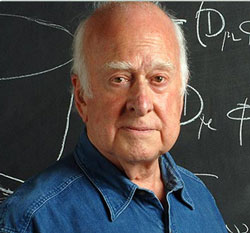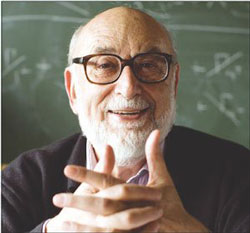Nobel Prize for the Higgs mechanism
François Englert and Peter W. Higgs have been awarded the 2013 Nobel Prize in physics “for the theoretical discovery of a mechanism that contributes to our understanding of the origin of mass of subatomic particles, and which recently was confirmed through the discovery of the predicted fundamental particle, by the ATLAS and CMS experiments at CERN’s Large Hadron Collider.” The announcement by the ATLAS and CMS experiments took place on 4 July last year. The Discovery center is a member of the ATLAS experiment.

Peter W. Higgs
The Brout-Englert-Higgs (BEH) mechanism was first proposed in 1964 in two papers published independently, the first by Belgian physicists Robert Brout and François Englert, and the second by British physicist Peter Higgs.
It explains how the force responsible for beta decay is much weaker than electromagnetism, but is better known as the mechanism that endows fundamental particles with mass.
A third paper, published by Americans Gerald Guralnik and Carl Hagen with their British colleague Tom Kibble further contributed to the development of the new idea, which now forms an essential part of the Standard Model of particle physics.

François Englert
The problem in 1964 was that the theory that could unify electromagnetism and weak interactions did not allow for explicit mass terms for the elementary particles. That is forbidden by the symmetry of the theory. However, it was know the the elementary particles had very different masses.
So Higgs and others proposed that the symmetry was broken spontaneously by the vacuum that would choose a certain value of the “Higgs field” to fill it out. They were inspired by a similar mechanism used to explain superconductivity.
As was pointed out by Higgs, a key prediction of the idea is the existence of a massive boson of a new type, which was discovered by the ATLAS and CMS experiments at CERN in 2012.
The Standard Model describes the fundamental particles from which we, and all the visible matter in the Universe, are made, along with the interactions that govern their behaviour. It is a remarkably successful theory that has been thoroughly tested by experiment over many years.
Until last year, the BEH mechanism was the last remaining piece of the model to be experimentally verified. It is important to realize that there were many other viable models that could do the same job: give masses to the particles.
Now that the Higgs boson has actually been found, many questions remain. The Standard Model is not as beautiful as we would wish and we know, in fact, from astrophysical observations that it is incomplete.
Experiments at CERN are therefore eagerly looking for physics beyond the Standard Model. The Higgs particle was discovered by the ATLAS and CMS collaborations, each of which involves over 3000 people from all around the world, including the Discovery center. They have constructed sophisticated instruments – particle detectors – to study proton collisions at CERN’s Large Hadron Collider (LHC), itself a highly complex instrument involving many people and institutes in its construction.
Jens-Jørgen Gaardhøje, Professor, Discovery Center, Niels Bohr Institute
